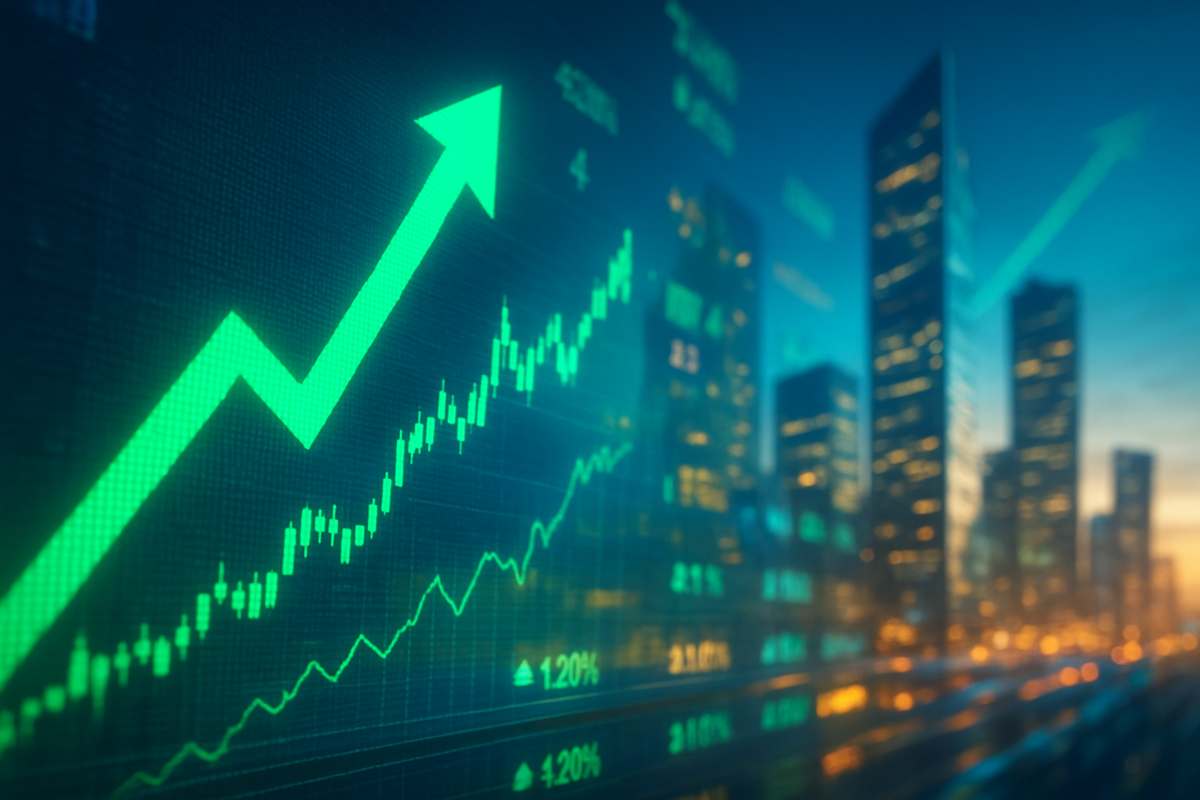
New York, NY – October 28, 2025 – The Dow Jones Industrial Average (DJIA) experienced a significant surge today, climbing over 300 points in a robust display of renewed investor confidence. This substantial daily gain signals a palpable shift in market sentiment, moving towards a "risk-on" environment as investors eagerly embrace equities and growth-oriented assets. The rally underscores a prevailing optimism, hinting at an improved economic outlook and potentially setting the stage for continued upward momentum in the broader market.
Such a powerful move in the Dow often reflects underlying strengths within the economy or positive corporate developments. It suggests that market participants are absorbing favorable news, whether it be encouraging economic data, strong corporate earnings, or anticipations of supportive monetary policies. For millions of investors, this translates directly into increased portfolio wealth and a brighter outlook on their financial futures, reinforcing the belief that the market's upward trajectory remains intact.
Unpacking the Market's Ascent
Today's impressive rally in the Dow Jones Industrial Average (DJIA) was not an isolated event but rather the culmination of several positive catalysts that converged to ignite investor enthusiasm. While specific details of a single trigger are often complex, significant daily gains like this are typically fueled by a combination of strong corporate earnings reports, optimistic economic data, and expectations of accommodative monetary policy. Many of the 30 component companies within the Dow, including industrial giants like 3M (NYSE: MMM), technology leaders such as Microsoft (NASDAQ: MSFT), and financial titans like Goldman Sachs (NYSE: GS), likely contributed to this broad-based advance.
Leading up to this moment, the market had been processing various economic indicators. A timeline often reveals a period of cautious optimism, where investors are on the lookout for definitive signals to commit capital. Recent weeks may have seen the release of manufacturing indices indicating unexpected resilience, or perhaps inflation data that suggested price pressures were easing more rapidly than anticipated. These macroeconomic improvements, coupled with a steady stream of corporate announcements—ranging from raised financial guidance to strategic corporate maneuvers—create a fertile ground for a market surge. Key players involved in such a rally extend beyond individual companies to include major institutional investors, hedge funds, and retail investors, all reacting to the same fundamental signals.
Initial market reactions extended beyond just the point gain, with increased trading volumes across exchanges, particularly in sectors that are highly sensitive to economic growth. Technology, industrials, and financial sectors often lead the charge during such rallies, as investors position themselves to benefit from a stronger economy. The market's enthusiasm was also likely reflected in a decrease in volatility measures, such as the VIX, indicating a reduction in investor anxiety and a greater willingness to take on risk. This positive feedback loop often encourages further buying, pushing asset prices higher across the board.
Companies Poised for Gains and Losses
A broad-market rally, particularly one driven by renewed economic optimism, typically creates a clear divide between potential winners and losers. Companies with strong cyclical exposure, meaning their fortunes are closely tied to the overall health of the economy, are often the primary beneficiaries. Industrial companies like Caterpillar (NYSE: CAT) and Boeing (NYSE: BA) tend to thrive as business investment and global trade pick up, leading to increased demand for their heavy machinery and aircraft. Similarly, financial institutions such as JPMorgan Chase (NYSE: JPM) and Visa (NYSE: V) benefit from increased economic activity, higher lending volumes, and greater consumer spending.
Technology giants, especially those with diverse revenue streams and strong market positions, also stand to gain significantly. Apple (NASDAQ: AAPL) and Salesforce (NYSE: CRM), for instance, often see their valuations climb as investor confidence in future growth prospects solidifies. Consumer discretionary companies, like Home Depot (NYSE: HD) or Nike (NYSE: NKE), can also experience a boost as consumers feel more secure about their finances and are more willing to spend on non-essential goods and services. The improved sentiment can lead to higher sales forecasts and, consequently, an upward revision of their stock prices.
Conversely, companies that might see less pronounced gains, or even relative losses, during such a rally are often those considered "defensive" plays. These include utilities, consumer staples, and certain healthcare companies that tend to perform well during periods of economic uncertainty. While their stock prices may not necessarily decline, their growth rates might lag behind the broader market as investors shift capital towards higher-growth opportunities. Additionally, companies with high debt loads or those highly sensitive to interest rate fluctuations might face headwinds if the rally is accompanied by expectations of future rate hikes, which could increase their borrowing costs.
Wider Significance and Broader Trends
Today's significant Dow surge is more than just a single-day event; it fits into a broader narrative of market resilience and evolving economic conditions. This rally could signal a pivotal moment, potentially confirming a bullish trend that has been building over recent weeks or months. It aligns with the broader industry trend of investors seeking growth and moving away from more conservative positions, especially if the underlying economic data continues to show improvement. This "risk-on" sentiment suggests a collective belief that the worst of any economic headwinds may be behind us, and that a period of sustained growth is on the horizon.
The ripple effects of such a strong market day can be far-reaching. Competitors within various sectors may feel pressure to demonstrate similar growth prospects or innovative strategies to keep pace with the market leaders. Partners, suppliers, and even smaller businesses within the supply chains of the Dow components could experience increased demand and improved business outlooks. From a regulatory or policy standpoint, a consistently strong market might influence central bank decisions, potentially leading to more cautious approaches regarding interest rate adjustments, or it could encourage policymakers to maintain supportive fiscal measures to sustain economic momentum.
Historically, significant daily gains in the Dow have often occurred at inflection points, either confirming the strength of a bull market or signaling a recovery from a downturn. Comparisons to similar events in the past, such as periods following robust earnings seasons or decisive policy actions, often reveal that such rallies can lay the groundwork for sustained market appreciation. However, it is crucial to note that while historical patterns provide context, each market cycle has its unique characteristics, influenced by current geopolitical events, technological advancements, and evolving consumer behaviors.
What Comes Next: Navigating the Future Market
The immediate aftermath of a significant market surge like today's will likely see continued scrutiny of economic data and corporate earnings. In the short term, investors will be watching for follow-through, seeking confirmation that this rally is not merely a transient spike but part of a more enduring upward trend. Key indicators to monitor include consumer confidence reports, manufacturing and services PMIs, and, crucially, the upcoming quarterly earnings releases from major corporations. A sustained period of positive economic news and strong corporate performance could solidify the market's bullish stance.
Long-term possibilities include a sustained bull market driven by innovation, productivity gains, and a healthy global economy. This could lead to further capital appreciation across various asset classes, benefiting diversified portfolios. However, potential challenges remain, such as unforeseen geopolitical events, persistent inflationary pressures, or a shift in central bank policy that could temper growth expectations. Strategic pivots or adaptations required from companies might include reinvesting profits into research and development, expanding into new markets, or optimizing supply chains to enhance resilience against future disruptions.
Market opportunities that may emerge include undervalued companies that have yet to fully participate in the rally, or sectors poised for secular growth, such as renewable energy, artificial intelligence, or biotechnology. Conversely, challenges could arise from overvalued segments of the market that become susceptible to corrections. Potential scenarios range from a continued "melt-up" as fear of missing out (FOMO) drives further buying, to periods of consolidation where the market digests its gains before resuming its climb. Investors should remain vigilant, adapting their strategies to the evolving market landscape.
Comprehensive Wrap-Up: A Resilient Market's Path Forward
Today's over 300-point gain in the Dow Jones Industrial Average serves as a powerful testament to the market's inherent resilience and the underlying strength of the economy. The key takeaway from this event is the clear indication of a returning "risk-on" sentiment, where investors are increasingly willing to allocate capital to equities, driven by a confluence of positive corporate news and encouraging macroeconomic indicators. This surge reinforces the idea that despite periodic volatility, the market has a fundamental capacity to rebound and generate wealth.
Moving forward, the market appears poised for continued scrutiny of both micro and macroeconomic factors. While the immediate outlook is positive, investors will be keenly observing upcoming inflation reports, employment figures, and, most importantly, the guidance provided by companies during their earnings calls. These will be critical in determining the sustainability of the current rally and the broader trajectory of the market. The Federal Reserve's stance on monetary policy will also remain a significant influencer, with any signals regarding interest rates likely to elicit strong market reactions.
The lasting impact of such a significant daily move can be profound, potentially setting a new baseline for investor confidence and recalibrating expectations for future returns. It underscores the importance of a well-diversified portfolio and a long-term investment horizon, as short-term fluctuations can often mask the underlying trends of growth. Investors should watch for consistent earnings growth, stable economic expansion, and prudent corporate management in the coming months, as these will be the bedrock for sustained market appreciation.
This content is intended for informational purposes only and is not financial advice






